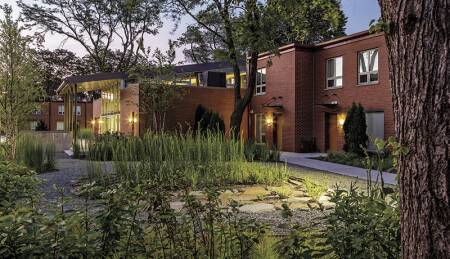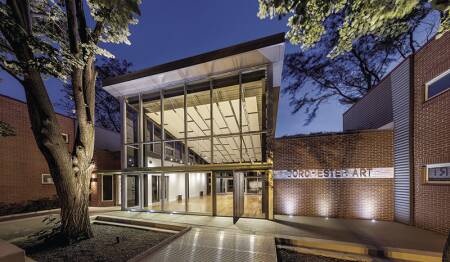Creative placemaking, an innovation that involves bringing art and culture in tandem with design to the beginning of a real estate development project, is gaining momentum around the globe, from small rural communities to large urban areas.
South Carolina’s 2017 Rural Summit, for example, sponsored by the state’s department of commerce and held in March, included a presentation and panel on creative placemaking for summit participants, who included council members, city administrators, planners, and others hungry for knowledge about how creative placemaking strategies can be used to revitalize their communities.
Of the 11 ULI 2016 Global Awards for Excellence recipients, four projects were selected largely because of creative placemaking features that contributed to their success. They were Wynwood Walls in Miami; the Strand American Conservatory Theater (ACT) in San Francisco; Tobin Center for the Performing Arts in San Antonio; and Daniels Spectrum in Toronto.
Daniels Spectrum, for example, a community cultural hub and part of one of the largest urban revitalization initiatives in Toronto, is a multifaceted community event, studio, and performance space with accompanying office space that offers a place for local artists, musicians, and businesses to congregate and formulate new ideas. It has hosted over 800 events and attracted more than 150,000 visitors, contributing to the economic vibrancy of the Regent Park community. The new ACT, with a 285-seat theater, educational facilities, a public lobby and café, and a black-box theater and rehearsal space, transformed the century-old movie theater into a nonprofit experimental performance space. The revived theater, with features that hark back to its past, serves as a key component of the revitalization of a desolate part of San Francisco, and is expected to attract over 100,000 visitors in its first year of operation. (Both award-winning projects are profiled in this issue, beginning on page 174.)
Grassroots community initiatives like Project Row Houses in Houston transformed 22 crime-plagued “shotgun” houses in the city’s oldest African American neighborhood into a thriving complex that has grown to 40 properties and provides space for housing, exhibitions, and other creative enterprises. Similarly, Dorchester Art + Housing Collaborative on Chicago’s south side transformed a blighted townhome development into 32 mixed-income artist housing units (12 public housing, 11 affordable, and nine market-rate) and offers a community center for residents. It is a part of the cultural renaissance of the Greater Grand Crossing community spearheaded by artist Theaster Gates and the Rebuild Foundation, in partnership with Brinshore Development.
These projects have a common theme of leading with art and culture and realizing outcomes that uplift and enliven, attract and connect people, promote health, and catalyze economic development. Implementing creative placemaking successfully, with measurable positive outcomes, can be realized by using best practices, gleaned from lessons learned on many projects over a long time.
During the discovery phase of a two-year creative placemaking project funded by the Kresge Foundation, as part of ULI’s Building Healthy Places Initiative, our research has identified ten best practices for project success.
Begin with the end in mind. Envision what you would like to see—such as artfully designed buildings, an inclusive community, gathering places that promote health—but also what you do not want to see, such as displacement of existing residents, lack of diversity, or exclusionary housing. Be clear about motivation and goals, then engage the right players to think outside of the box to achieve those goals. Set no limits on the possibilities for combining art and culture with the built environment. For example, New York City’s Sugar Hill Children’s Museum in Harlem broke with convention by being the first art museum in an affordable housing complex.
Bring in artists and the community early. Timing is everything. Art and culture need to be central to the project’s design. Early engagement of these essential resources will facilitate a project that is well designed and inclusive and that meets the needs of the larger community. In 2015, ArtPlace America awarded six organizations in cities spanning the United States $3 million each to demonstrate the impact of early engagement of arts and culture in community development. Each organization will receive the $3 million over a three-year period. ArtPlace engaged PolicyLink to work with them to identify and share insights and best practices with the goal to make the grant recipients’ social, physical, and economic placemaking strategies more inclusive.
“Mine” local art and cultural assets. Understand what jewels exist in the community. Creative placemaking works best when it is used to amplify local community assets, fostering a sense of pride. Learn about the community’s history and aspirations. Practice radical listening—meaning, keep a laser focus on one of author Stephen Covey’s “seven habits:” seek first to understand. For instance, the Mill Hill arts village in Macon, Georgia, learned after its cultural-asset mapping that many residents like to cook. So, its new art center in the renovated auditorium will have a culinary art school.
Engage local artists. Find and recruit artists in the local community, including visual artists, performing artists, poets, writers, musicians, designers, chefs, and other creative types. Engaging local artists will help build buy-in. It is hoped there will be no need to find talent elsewhere. The Macon Arts Alliance learned this hard lesson after bringing artists from outside the state to Mill Hill for an art initiative. It created an atmosphere of distrust, leading the alliance to rescind its action and rebuild the relationship. Consult local arts organizations and local and state government art councils to find local artists. For example, in the Washington, D.C., metro area, the Washington Project for the Arts (WPA) is a nonprofit group dedicated to promoting the careers of artists and boasts a membership of thousands of local artists. Local art councils include the District of Columbia Commission on Arts and Humanities, the Arts and Humanities Council of Montgomery County (Maryland), and the Virginia Commission for the Arts.
Understand and articulate stakeholder benefits. Explore how art and culture can contribute to both the social and economic vitality of a project. Be prepared to discuss benefits from various points of view. Focus on community-driven outcomes and what is meaningful to locals, but also focus on the hard facts needed to sell the project to private-sector investors and others. For example, the community may be interested in the project’s impact on reducing crime or providing more activities for youth and seniors, while developers may need to quantify the project’s impact on accelerating lease-ups or reducing project costs.
Form cross-sector partnerships, including artists, community members, and public- and private-sector organizations. Having local community organizations engaged is key along with the involvement of local government, philanthropy, and other nonprofit partners. The Mill Hill Arts project had a variety of local, state, and federal partners, including the Macon Arts Alliance, the Urban Development Authority, Macon–Bibb County, local hospitals, the White House Strong Cities Strong Communities initiative, the National Endowment for the Arts (NEA), the Knight Foundation, and others.
Identify the critical skills needed to deliver on project goals and outcomes. In addition to the skills provided by designers, architects, and artists, what other skills are needed? Collaboration is critical to the success of a project. Identify which skills are needed, match needs to the people within the group who have the necessary skills, and identify gaps that need to be met by recruiting new team members with new skills. Also make teams intergenerational by including youth and senior members. Your project team should reflect the inclusive nature of the project vision and goals.
Look for early wins to generate excitement, visibility, and buy-in. For example, use pop-ups to draw people in and community gatherings to gain engagement. A good example is the Hall in the Tenderloin community of San Francisco. This pop-up culinary art project provides stalls for six food vendors, a bar, and free meeting space for local nonprofit groups, while the developer awaits entitlement to build a mixed-use retail and residential project with affordable housing on that site.
Maintain a long view. Don’t stop when the goals of the built environment are met. Consider programming that keeps the community engaged and the place alive and exciting. Monroe Street Market in Northeast Washington, D.C., a $250 million mixed-use transit-oriented development, engaged a nonprofit arts organization, CulturalDC, to manage its arts walk and relationship with artists in its 27 affordable artist studios on the ground floor of two buildings in its complex. CulturalDC, with local nonprofit Dance Place, supports Third Thursdays open artists’ studios, dance, and other programs on an ongoing basis.
Pursue creative financing. Where there is a will, there is a way. Money can come from unforeseen, unexpected places. Bethlehem Steel Stacks, the site of a former steel mill in Bethlehem, Pennsylvania, transformed into a sprawling art center, was funded through revenues from the local casino, which is also on the site of the old mill. Funding for the Harlem Sugar Hill affordable housing and museum complex in this New York City neighborhood was pieced together from 13 funding sources, including private lenders, philanthropy, low-income housing tax credits, HOME funds, and new markets tax credits. If your vision is the right one, for the right reasons, with appropriate stakeholder benefits, the money will come. Persevere.
Creative placemaking strategies have been used successfully across many dimensions in the built environment. Housing and public spaces have been highlighted here, but creative placemaking can also be applied to transportation, health, infrastructure, and environmental systems. All stakeholders—community residents and businesses, government, developers, and other partners—stand to benefit. Creative placemaking strategies, when properly applied, can help differentiate a real estate development project, as ULI’s Global Awards for Excellence program demonstrates, while simultaneously addressing social, economic, environmental, and other challenges.
Many examples of successful creative placemaking initiatives exist, but there also are examples of failed ones or ones that have fallen short of meeting intended goals or outcomes. Using best practices has proved to differentiate the most successful projects, and has helped revitalize and foster healthy, sustainable communities. This is certainly a gain not only for affected communities, but also for everyone. Indeed, it is a gain for the greater global community of which we are all a part. UL
Juanita Hardy is senior visiting fellow for creative placemaking at ULI. Hardy has over 43 years of business experience, including 31 years with IBM and ten years with Right Management, a global executive coaching and human capital development firm. She also has been active for over 30 years as a collector of fine art, a trustee on national nonprofit art boards—ArTrain USA (former) and ArtTable—and is a former executive director of CulturalDC, a Washington, D.C.–based nonprofit art organization serving artists, nonprofit art organizations, developers, and property owners.






